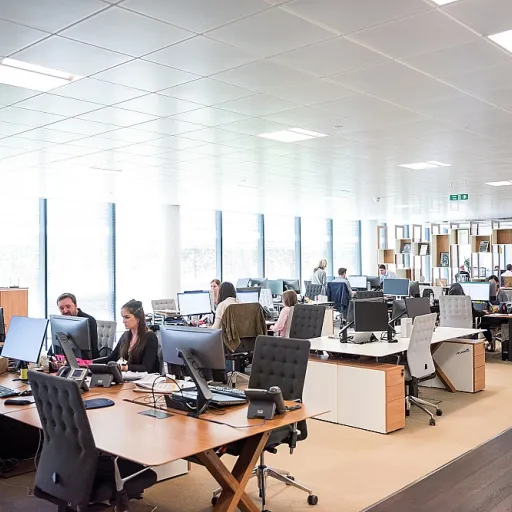
Understanding shrm 25 and its relevance to continuous learning
What Makes SHRM 25 a Pivotal Event for Continuous Learning?
The SHRM 25 annual conference in San Diego stands out as a major event for professionals eager to stay ahead in the evolving world of workplace learning. As organizations face rapid changes in talent acquisition, leadership development, and workplace culture, SHRM 25 provides a unique platform to explore cutting edge strategies and solutions. The event brings together a diverse network of professionals, board directors, and SHRM members, all focused on shaping the future of continuous learning.
Why SHRM 25 Matters for Organizations and Individuals
SHRM 25 is more than just an expo or a series of sessions. It is a stage where the latest insights into membership software, talent retention, and leadership development are shared. By attending SHRM, organizations can discover new opportunities to build a culture that supports ongoing learning and development. For individuals, the conference offers a chance to register for sessions that spotlight practical strategies for personal and professional growth.
- Access to main stage and spotlight stage presentations on future workplace trends
- Opportunities to network with top talent and industry leaders
- Insights from the SHRM Foundation on supporting learning initiatives
- Guidance on how to retain top performers through continuous learning
Connecting SHRM 25 to Broader Business Challenges
Continuous learning is not just a buzzword; it is a necessity for organizations aiming to thrive in a competitive landscape. The annual conference in San Diego addresses real-world challenges, from digital transformation to talent management. For a deeper understanding of how these challenges impact business operations, you can explore key challenges in scaling business operations and see how continuous learning strategies can help organizations adapt and grow.
By participating in SHRM 25, both organizations and individuals gain the experience and insights needed to foster a culture of learning, making it an essential event for anyone committed to future-ready talent development.
The role of digital transformation in continuous learning
How Digital Tools Are Transforming Learning Experiences
Digital transformation is reshaping how organizations approach continuous learning, especially at events like the SHRM annual conference in San Diego. The integration of cutting edge technology into learning strategies is not just a trend—it’s a necessity for organizations aiming to stay ahead in talent acquisition and leadership development. Today, membership software and digital platforms allow SHRM members to access learning sessions, register for events, and connect with network professionals from anywhere. This flexibility means that learning is no longer confined to a single stage or physical location. Whether attending the main stage, spotlight stage, or exploring the expo, participants can experience tailored content and insights that fit their needs.- On-demand learning: Digital platforms offer opportunities to learn at your own pace, making it easier to fit professional development into busy schedules.
- Interactive sessions: Virtual and hybrid formats at the SHRM annual event provide live Q&A, polls, and networking, enhancing engagement and knowledge retention.
- Data-driven insights: Organizations can now measure the impact of learning initiatives more effectively, using analytics to refine strategies and retain top talent.
Building a culture of continuous learning in organizations
Fostering a Learning Mindset Across the Organization
Creating a culture where continuous learning thrives is a priority for organizations aiming to stay ahead in today’s rapidly changing workplace. The annual SHRM conference in San Diego highlights how leaders can leverage cutting edge strategies to nurture this mindset. At the event, sessions on leadership development, talent acquisition, and workplace culture provide actionable insights for HR professionals and board directors seeking to build environments where learning is part of daily experience.
Organizations that prioritize learning offer more than just training—they create opportunities for employees to explore new skills, attend SHRM sessions, and network with professionals from diverse backgrounds. Membership in SHRM or participation in the SHRM Foundation’s initiatives can open doors to resources and events that reinforce the value of ongoing education. These experiences, whether on the main stage or spotlight stage, help retain top talent and support leadership at every level.
- Encourage participation: Register for SHRM annual events and promote attendance among teams to expose them to the latest trends and best practices.
- Leverage membership software: Use digital tools to track learning progress and recognize achievements, making learning visible and valued.
- Integrate learning into workflows: Make continuous learning part of daily routines, not just a once-a-year activity at the expo.
- Spotlight success: Share stories from SHRM members who have advanced through learning, inspiring others to follow.
Building this culture is not just about formal programs. It’s about leadership modeling curiosity, providing access to resources, and celebrating learning wins. For organizations looking to craft a digital strategy that supports lifelong learning, explore practical approaches to digital transformation in learning. By embedding these strategies, organizations position themselves to attract and retain top talent, ensuring their teams are ready for the future of work.
Overcoming resistance to continuous learning
Addressing Common Barriers to Continuous Learning
Organizations aiming to stay ahead in talent acquisition and leadership development often face resistance when introducing continuous learning initiatives. Even with the momentum from events like the SHRM annual conference in San Diego, where cutting edge strategies are shared on the main stage and spotlight stage, many professionals encounter challenges in fostering a learning culture.
Why Resistance Happens
Resistance to continuous learning can stem from several sources within an organization:
- Fear of Change: Employees may worry that new learning requirements will disrupt their established workflows or expose skill gaps.
- Lack of Time: With busy schedules, finding time for sessions or new opportunities can feel overwhelming.
- Unclear Value: If the benefits of learning are not communicated, team members may question the relevance of new initiatives.
- Technology Barriers: Not everyone is comfortable with new membership software or digital platforms, even as digital transformation becomes central to the future of work.
Strategies to Overcome Resistance
Drawing from insights at the SHRM 25 event and the experience of network professionals, several strategies can help organizations and individuals embrace continuous learning:
- Communicate the "Why": Clearly explain how learning opportunities connect to personal growth, talent retention, and the organization’s future.
- Leverage SHRM Membership: Encourage employees to register as SHRM members to access exclusive resources, board directors’ insights, and leadership development programs.
- Flexible Learning Formats: Offer sessions in various formats—live at the expo, on-demand, or virtual—to fit different learning styles and schedules.
- Spotlight Success Stories: Share examples from the annual conference or within your organization where continuous learning led to measurable improvements in workplace culture or talent outcomes.
- Support from Leadership: When leaders attend SHRM events and model learning, it signals the importance of staying current and encourages others to follow.
Creating Lasting Change
Building a culture that values learning is not a one-time event. It requires ongoing commitment, regular feedback, and recognition of those who engage. By exploring the opportunities presented at the SHRM annual conference in San Diego and integrating these strategies, organizations can retain top talent and ensure their teams are prepared for the future. Membership in SHRM and participation in events like Diego SHRM provide a strong foundation for continuous improvement and innovation in the workplace.
Measuring the impact of continuous learning initiatives
Evaluating Progress and Success in Learning Initiatives
Measuring the impact of continuous learning is essential for any organization aiming to stay ahead in today’s competitive landscape. With the rise of digital transformation and the influence of major events like the SHRM annual conference in San Diego, organizations are under increasing pressure to demonstrate real results from their learning strategies. To ensure that learning initiatives are not just a checkbox exercise, but truly drive talent acquisition and retention, organizations need clear methods to assess effectiveness. Here are some practical approaches:- Set Clear Objectives: Before launching any learning program, define what success looks like. Is it improved leadership development, higher employee engagement, or better workplace culture?
- Track Participation and Engagement: Use membership software or learning platforms to monitor who attends sessions, completes courses, or participates in main stage and spotlight stage events at conferences like SHRM 25.
- Assess Knowledge Retention: Post-session quizzes, practical assignments, and feedback surveys help gauge how much employees actually learn and apply.
- Link Learning to Performance: Analyze whether those who engage in continuous learning show measurable improvements in their roles. This could mean faster onboarding, increased productivity, or better talent retention.
- Gather Qualitative Insights: Collect stories and feedback from SHRM members, board directors, and network professionals who attend SHRM events. Their experiences offer valuable perspectives on what works and what needs improvement.
Practical steps for individuals to engage in continuous learning
Taking Charge of Your Learning Journey
Continuous learning is not just an organizational priority discussed at the SHRM Annual Conference in San Diego; it’s a personal commitment. Whether you’re a SHRM member, HR professional, or someone aiming to stay ahead in talent acquisition, the journey starts with individual action. Here are practical strategies to help you engage in lifelong learning and make the most of opportunities presented by events like SHRM 25.
- Leverage Membership Benefits: If you’re part of SHRM or considering membership, explore exclusive resources, webinars, and leadership development sessions. Membership software often includes access to cutting edge insights and tools to help you grow.
- Register for Conferences and Expos: Attending events such as the annual conference in San Diego or the SHRM Expo provides direct access to main stage presentations, spotlight stage discussions, and networking with board directors and other professionals. Register early to secure your spot and maximize your experience.
- Participate in Digital Learning: Many organizations, including SHRM, offer digital sessions and on-demand content. These allow you to learn at your own pace, revisit key topics, and stay updated on the latest trends in workplace culture and talent management.
- Engage with Your Network: Connect with network professionals you meet at events or through SHRM membership. Sharing experiences and insights can open new opportunities and help you retain top knowledge in your field.
- Set Personal Learning Goals: Identify the skills or knowledge areas you want to develop. Use strategies discussed at SHRM 25, such as microlearning or mentorship, to structure your learning and track your progress.
- Explore Leadership Development: Take advantage of leadership development programs offered by SHRM Foundation or your organization. These initiatives are designed to prepare you for future roles and help your organization retain top talent.
By actively seeking out these opportunities—whether at the SHRM annual event in San Diego, through digital platforms, or by leveraging your membership—you position yourself to thrive in a rapidly changing workplace. Stay curious, stay engaged, and make continuous learning a core part of your professional journey.












